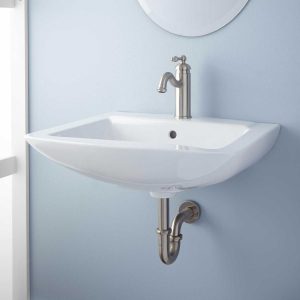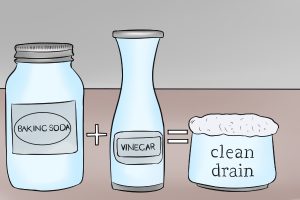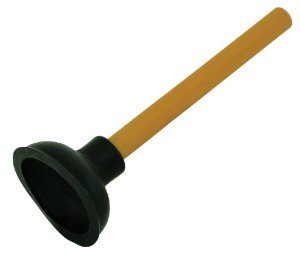Completely clogged or slow draining bathroom sinks are very common. The good part is that the bathroom sink drain can be unclogged within ten or fifteen minutes.
What Causes a Bathroom Sink Drain Clog?
 The main causes for this clog are hair and soap. The soap residue creates a greasy medium in which hairs easily get tangled. Other small debris easily stick with a ball of hair. This avalanche effect will create a larger clog in no time leading to a block in water draining or reduction in draining speed.
The main causes for this clog are hair and soap. The soap residue creates a greasy medium in which hairs easily get tangled. Other small debris easily stick with a ball of hair. This avalanche effect will create a larger clog in no time leading to a block in water draining or reduction in draining speed.
If you look under the sink, you would see a curved U-shaped pipe. This is where most of the clog occurs due to the slow upward movement of water in the curve. The U-shape has been added for a reason. This curve will allow a small amount of water to get stagnated inside the pipe always. This stagnated water will pull in a lot of clog and create the blockage but, it is also very essential to block the sewer gas from entering to the house through the sink.
Since they are organic or easily dissoluble with mild chemicals, there are numerous simple ways to unclog a bathroom sink.
Easiest Way To Unclog A Bathroom Sink Drain:
The first part to unclogging a bathroom sink drain is to remove the stopper. There will be a small pivot rod nut in the middle, which can be pulled out. Mostly, it can be done with hand but, if needed, use pliers. Once the rod is pulled out, you can easily remove the stopper. Now, you see a strained steel with many holes. This is the opening of the drain.
Then add a gallon of hot boiling water into the bathroom sink drain, after removing the stopper. In most cases, the boiling water will do the magic. Completely empty the pot into the sink and let the water flow into the pipes in greater speed. If this method did not work, there are a lot of methods to try out.
Before we try out other methods, remember that clog is not the only reason for blocked draining or slowed draining. Improper installation of the pipe, damage in pipe or cracks in pipe can reduce the pressure and can lead to blockage.
Top 12 Ways to Clean Bathroom Sink Drain
Below, I have wrote a list of methods that can be used to unclog a bathroom sink drain:
1. Unclog Bathroom Sink Drain Baking Soda With Vinegar Combination
 It is a very common old school method to remove clog in any drain. Baking soda will react with vinegar. This creates salt and carbon di-oxide. This reaction is called as neutralization reaction. This will help to dissolve certain types of gunk and help to remove clog. Put ½ cup of the soda on the drain. You need not be very sure about getting all the soda into the drain. Add ½ cup of vinegar to the drain in such a way that it washes out all baking soda particles in the sink bowl. You can use any type of vinegar for this method. For some, this might give out an unpleasant odor. If you feel so, add juice of a lemon along with vinegar. The bubbling mixture would clear out the clog. Add a liter of hot boiling water into the drain to wash out any remaining parts of the clog.
It is a very common old school method to remove clog in any drain. Baking soda will react with vinegar. This creates salt and carbon di-oxide. This reaction is called as neutralization reaction. This will help to dissolve certain types of gunk and help to remove clog. Put ½ cup of the soda on the drain. You need not be very sure about getting all the soda into the drain. Add ½ cup of vinegar to the drain in such a way that it washes out all baking soda particles in the sink bowl. You can use any type of vinegar for this method. For some, this might give out an unpleasant odor. If you feel so, add juice of a lemon along with vinegar. The bubbling mixture would clear out the clog. Add a liter of hot boiling water into the drain to wash out any remaining parts of the clog.
Do not prepare this solution, beforehand. The effect of this solution reduces when the bubbles stop appearing. You can use this method as many times as you wish. This method will not damage the pipes and it is a very good preventive measure too. Adding this solution once a week or once a month would remove any small gunk in the pipe and your bathroom sink drain would never get clogged.
- Read in Details: How To Unclog A Drain With Baking Soda?
2. Chemical Drain Opener for Unclogging Bathroom Sink Drain
There are a lot of brands of chemical drain openers. There are a few which are specifically marketed for bathroom sink drain. Choose a brand wisely and follow the instructions given on the bottle. After trying the chemical drain opener, you should not add any other solution into the drain, which includes another brand of drain opener, vinegar, soda or even any method that involves pressure.
You can use a snake to pull clog out after using chemical drain opener. Some of the chemicals take four to five hours to work on the clog. So, use it overnight and leave it as such for the chemicals to work. Do not flush it with hot water. Use lukewarm or cold water.
Every year, many new products are marketed for the sole purpose of drain unclogging. You are welcome to try out all brands in a trial and error basis too. However, do not mix any two chemical drain cleaners. It may cause adverse effect due to unwanted chemical reaction. Moreover, if a chemical solution worked during a clog mishap, it does not assure you that it would work all the time, as the type of clog and location of the clog have greater impact on the output.
- Important Read: Which Alkali Is Used To Open A Drain?
3. Pipe Cleaning Method
This method works only if the clog is very close to the drain. Right under the sink, you would find a U-shaped tube. It can be easily detached from the other parts of the plumbing.
First, keep a large bowl under the tube, as the whole process can get messy. Wear gloves and have some tissues or cleaning cloth, near you. Now follow these steps:
- Unscrew the U-pipe and empty the water into the tub.
- Remove any clog like hair or soap in the tube. The next piece to remove is the tall one that is connected to the sink. You can unscrew it like a normal screw.
- Use an old toothbrush to push out the debris from the pipe.
- There will be another small pipe which connects to the sink and cannot be detached. Insert the toothbrush into the pipe and remove the waste from the pipe.
- Clean the pipe attached to the wall or to the sewers with the toothbrush.
- Assemble back the parts and check it twice before you start the water.
- It is better to add baking soda and vinegar solution first and flush it out with hot water. This will remove any remaining gunk in the pipe.
Make sure not to damage the pipes while removing or cleaning. If the clog remains even after cleaning the pipes, the clog is very far away from the bathroom sink drain and you would need professional help to remove the clog. While screwing back, remember not to damage the thread as it would lead to water leak which is totally another huge problem.
4. Snake or Auger or Bent Wire to Unclog Bathroom Sink Drain

Basically you need a small wire bent at one corner to pull out the clog that is blocking the way in the bathroom sink drain. Your regular wire based coat hanger would also do good but, in some cases the hanger tend to get tangled inside the drain leading to serious problems. It is better to stick to a plumber’s snake or auger.
Follow these steps:
- Remove the stopper and insert the snake into the drain.
- Move the snake slowly till you feel a resistance.
- Now, slowly rotate the snake so that the hooks get tangled with the clog.
- Now, pull the snake out in rotational movements. Do not push the gunk too deep with the snake. The aim is to pull it out.
- After removing the gunk, add hot water through the drain to clear out any remaining gunk.
This method works well when the clog has any small metal items or rust. These would be very hard to dissolve and thus, it is better to pull it out. There are chemical drain openers that work on rust based clog too. You can use whichever is comfortable for you. While using this method, always remember:
- If you were not able to find the clog, the clog is very close to the sewer line and it is better to call professionals.
- If you were able to find the clog and were not able to pull it out, the clog is very hardened due to various factors like the type of debris, time period of collection and so on. Use any solution to loosen the debris and then use the snake. We will talk about a lot of solutions in details in this article.
- Violently shagging the snake would lead to cracks in the pipes. In some cases, already cracked pipe due to wear and tear would break with the snake’s violent movement.
- If the snake gets tangled anywhere in the pipeline, try to pull it out slowly or call professionals. If you damage the line, it would be an expensive and time consuming repair.
Usually, there would be no need for electrical auger. If you are planning to use one, you need to make sure to use less pressure to avoid any damage to the lines.
- Read in details: How To Use A Drain Snake?
5. Unclog Bathroom Sink Drain Using Plunger
 This is not a new method or a complex one. You are giving an additional pressure to push the clog in by creating a vacuum. Many stores and supermarkets sell plungers.
This is not a new method or a complex one. You are giving an additional pressure to push the clog in by creating a vacuum. Many stores and supermarkets sell plungers.
Place the plunger over the drain after removing the stopper. You can apply petroleum jelly on the sides of the plunger for a good grip. The jelly is optional. You should have some water around the plunger for better results. Decompress and press down repeatedly in a fast movement. Once the water starts flowing into the drain faster, the job is done.
Sometimes, the clog might rise up to the sink and you need to manual remove it and not flush it into the bathroom sink drain again.
Electric plungers are available for use. But, over-pressure might damage pipelines. Use with caution.
6. Caustic Soda for Removing Bathroom Sink Drain Clog
Caustic soda is also called as Sodium hydroxide. You can get it at any hardware store. Wear gloves and have some eye protection, before you handle caustic soda. Add ¾ gallon of cold water into a bucket and add three cups of the soda into it and stir well with a wooden spoon. It will start to heat up. Pour this solution into the bathroom sink drain and wait for 20 minutes. Flush the drain with hot water and repeat it again.
Do not use hot water, while creating the solution. Do not mix any chemical solutions with the caustic soda. There is no chance of damaging the pipeline in this method and you can use this method as many times as you wish.
7. Salt and Soda to Unclog Bathroom Sink Drain
Just like acid and soda, salt and soda also help to remove clog by dissolving them. Add ½ cup of table salt with equal amount of baking soda. Add it to the drain ad let it stay there for 10 minutes. Add some boiling water and push the mixture into the bathroom sink drain. In most cases, it is just an additive method. This helps to loosen the clog and you need to use any other method to remove the clog. Do not use chemical drain openers after using this solution. You can either use vinegar with baking soda or any mechanical method.
8. Use Dish Detergent for Unclogging Bathroom Sink Drain
This method will work if the clog is mostly of grease based residue. The dish detergent will act as lubricant and it will break down the residue. This is just an additive ingredient. The dish detergent alone cannot do the magic. You might have to use any other method like plumbing or snaking after adding the detergent. This excludes any brand of chemical drain opener including the ones that specially created for grease based clogs.
9. Bio Drain Cleaners to Unclog Bathroom Sink Drain
These are bacterial enzymes that feed on organic wastes and release no harmful element as waste product. These enzymes come in either powder or tablet form. Add them to the bathroom sink drain and follow the instructions given in the pack. Do not use any solution or even hot water while they are in action. It might kill the bacteria. Eco-friendly people and people who do not want harsh chemicals in their home can try this type of drain cleaners.
10. Gravity and Pressure
This is an additional method, which you can use. This would increase the speed of clog removal but cannot act as a method by itself. After performing any of the above stated method, place the stopper back. Close the drain and fill the water to the highest level. Remove the stopper. 40 gallons of water would gush into the bathroom sink drain which would insert a lot of pressure on the clog and dislodge it. You can also use a plunger after this to make sure that the water gets drained completely.
11. Use Drain Stick to Unclog Bathroom Sink Drain
Drain stick is a long flexible stick, which is barbed. This is a very good method if your clog is totally of hair. Insert the stick into the drain after removing the stopper. You can twist and turn the stick with ease. Once you get near the clog, rotate the stick so that the hair gets tangled in the barbs. Now, pull the stick out.
12. Wet / Dry Vacuum to Unclog Bathroom Sink Drain
You can also use a wet / dry vacuum to unclog your drain. If you had used the chemical drain opener, wait for a day to try this method.
A wet / dry vacuum is very similar to the normal vacuum that you use for your floor. But its design allows it to suck up dirty drain water and gunk all at once and deposit in a large waterproof canister, rather than a dry dust bag. Learn the instructions and do not wear any loose clothing or accessories while operating it. Check the foot switch and learn every control before you actually try it on the bathroom sink drain.
Keep the pressure to the minimum and slowly increase it, if needed. It is better to use a wet vacuum that has enough power to pull out clogs. If the clog was not removed, it is better to leave it to professionals to use high power vacuum.
Plumbers Help to Unclog a Bathroom Sink Drain
If the clog is too thick or if it is located far from the drain line, it is not easy to unclog it. You need professional help. There are many high speed suction machines and longer augers which will help in this case. These might be available for rent in many stores. These are professional and complicated methods which needs a lot of practice. Thus, it is better to leave it to the professionals.
Every time you unclog a bathroom sink drain using any mechanical method, a small wear and tear occurs in the pipeline. To avoid this, it is better to take preventive measures to reduce the frequency of clog and blockage. Vinegar and baking soda solution would help to remove any residue or waste from the drain, before it creates a larger clog. You can also use mild chemical drain cleaners for preventive measures.
Word of Advice:
There are numerous ways to unclog a bathroom sink drain. This article focuses on all working methods. Not all methods may be effective as the effectiveness of the method depends on the type of clog, location of the clog and many other factors. You can try out one method after another. If you think it is too complex, you can always hire professional help. Any damage to the pipes would cause a bigger problem, leading to an expensive repair. There are a lot of service providers with extended knowledge in dealing with clogged drain.